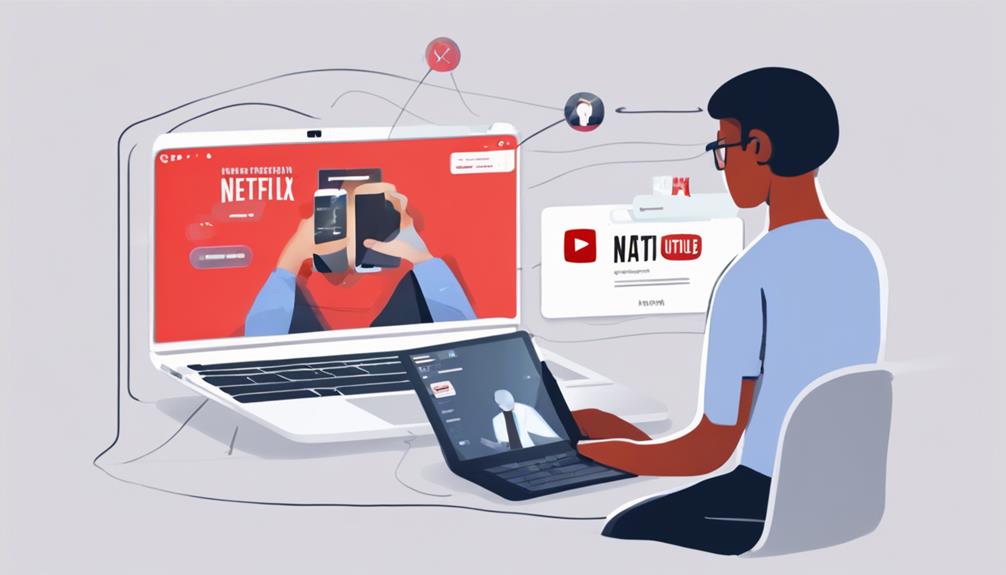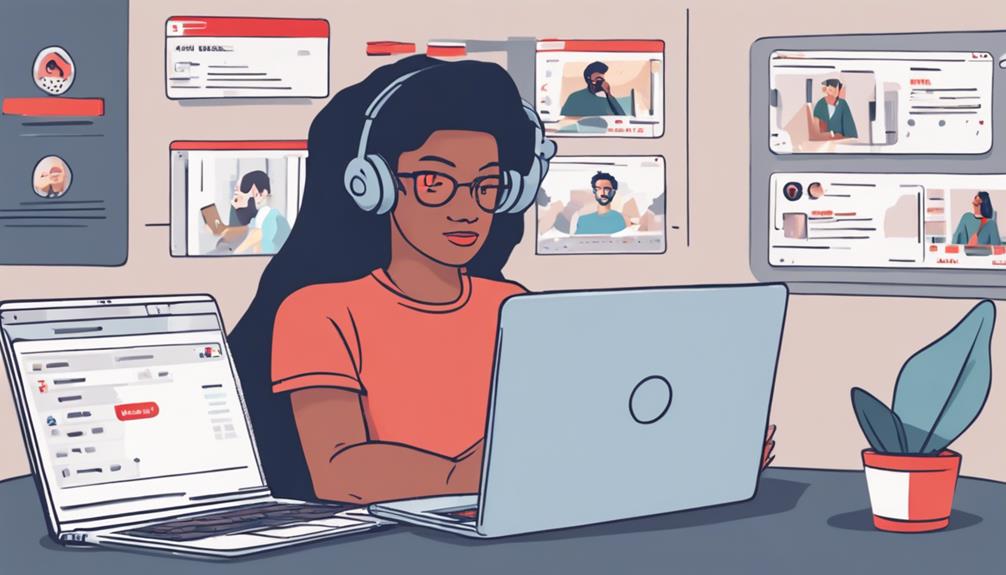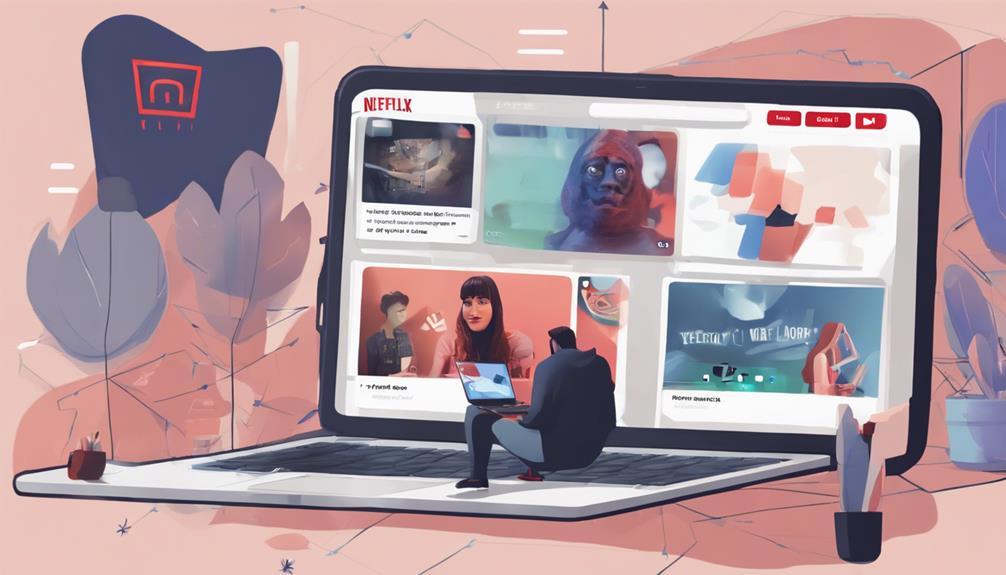When you settle in for a night of streaming, have you ever wondered how YouTube seems to know your Netflix preferences? The connection between your viewing habits on different platforms may not be as straightforward as you think. Algorithms play a pivotal role in deciphering your tastes and tailoring recommendations, but how do these platforms manage to keep up with your ever-evolving interests?
Stay tuned as we unravel the intricacies of data tracking, user profiling, and the mechanisms behind personalized content suggestions to shed light on this intriguing phenomenon.
Key Takeaways
- YouTube and Netflix use distinct algorithms for personalized recommendations.
- Limited cross-platform data integration between YouTube and Netflix.
- User behavior analysis in YouTube shapes personalized recommendations.
- Future focus on collaborative filtering and user consent for enhanced personalization.
Data Tracking and User Profiling

Data tracking and user profiling on YouTube involve monitoring your online activities and interactions to create personalized recommendations based on your preferences and behavior. When you watch YouTube videos, the platform collects data on the content you engage with, the duration of your views, and even your interactions such as likes, comments, and shares. This information forms the basis of user profiling, where YouTube analyzes your preferences to suggest relevant videos. By understanding your viewing habits, YouTube can tailor recommendations to match your interests accurately.
Moreover, user profiling delves into your behavior on the platform, including the types of videos you frequently watch and the topics that appeal to you. This meticulous tracking enables YouTube to create a detailed profile of your preferences, ensuring that the videos recommended align closely with your tastes. Your interactions with YouTube videos are crucial in shaping the personalized content you encounter on the platform, highlighting the significance of data tracking and user profiling in enhancing your viewing experience while safeguarding your privacy.
Algorithms Behind Content Suggestions
When it comes to content suggestions on YouTube and Netflix, the algorithms powering these platforms operate independently, tailoring recommendations based on your specific interactions within each respective platform.
- Algorithm comparison: YouTube and Netflix utilize distinct algorithms to analyze your viewing behavior and provide personalized recommendations tailored to your preferences.
- Machine learning: Both platforms leverage machine learning techniques to enhance the accuracy of their content suggestions, continuously refining their algorithms based on user interactions.
- Personalization accuracy: YouTube and Netflix focus on maximizing personalization accuracy by analyzing vast amounts of data to understand individual preferences and viewing habits.
- Data encryption: Both platforms prioritize data privacy and security, employing robust encryption methods to safeguard user information and ensure confidentiality.
Cross-Platform Data Integration

To enhance user privacy and adhere to data protection regulations, cross-platform data integration between YouTube and Netflix isn't a common practice. Companies like Google and Netflix maintain separate data systems to safeguard user information.
Data encryption methods are employed to ensure that sensitive viewing data remains secure and inaccessible across platforms. User consent policies play a crucial role in determining how data can be shared between services.
Legal implications related to data sharing and privacy violations further discourage direct integration of viewing histories between YouTube and Netflix. By keeping their databases distinct, these platforms maintain a level of privacy for users.
While YouTube and Netflix may use different algorithms to recommend content, the separation of data helps mitigate privacy concerns and ensures that user preferences are safeguarded within each platform's ecosystem.
Personalized Recommendations Mechanism
For enhanced user personalization and content discovery on YouTube, the platform tailors recommendations based on your activity and interactions within its ecosystem. Predictive modeling plays a significant role in suggesting videos that align with your viewing habits. Here are four key aspects of YouTube's personalized recommendations mechanism:
- User Engagement: YouTube analyzes metrics like watch time, likes, comments, and shares to understand your preferences accurately. This data helps in recommending content that's likely to capture your interest.
- Content Curation: The platform employs sophisticated algorithms to curate a diverse range of videos based on your historical interactions. By considering the genres, topics, and creators you engage with, YouTube offers a personalized selection of content.
- Predictive Modeling: Utilizing machine learning algorithms, YouTube predicts the type of videos you might enjoy watching next. These predictions are refined over time as you interact more with the platform.
- Privacy-Focused Approach: While delivering personalized recommendations, YouTube ensures user data privacy by keeping the recommendation systems independent from other platforms like Netflix. Your viewing history on Netflix remains separate from YouTube's recommendation algorithm, safeguarding your privacy.
User Behavior Analysis Techniques

Analyzing user behavior on YouTube involves tracking your interactions within the platform to personalize recommendations based on your viewing history and engagement with videos. YouTube's algorithms scrutinize your viewing patterns, content consumption habits, and behavioral analysis to understand your preferences accurately. By monitoring your likes, comments, and subscriptions, YouTube tailors suggestions that align with your interests. These user behavior analysis techniques are crucial for YouTube to enhance your viewing experience by offering content that resonates with you.
Furthermore, YouTube utilizes machine learning algorithms to delve deeper into your behavioral patterns and predict your preferences more effectively. This constant analysis of your interactions enables YouTube to refine its recommendations continuously. While these methods aim to provide personalized content suggestions, it's essential to consider the privacy implications of such detailed behavioral tracking. YouTube's commitment to improving user experience through sophisticated behavioral analysis underscores the platform's dedication to enhancing user satisfaction while balancing privacy concerns.
Targeted Advertising Strategies
Understanding how YouTube utilizes targeted advertising strategies is essential for comprehending the personalized ads you encounter on the platform based on your online activity and interests. Here's how YouTube tailors ads to you:
- Data Encryption: YouTube employs data encryption techniques to secure the information gathered about your online behavior, ensuring that your data remains protected from unauthorized access.
- Tracking Limitations: While YouTube tracks your interactions on their platform, they've limitations on the extent of data they can collect from external sources like Netflix, ensuring a level of privacy and data protection.
- User Consent: By agreeing to YouTube's terms and conditions, you provide consent for them to use your data for targeted advertising, emphasizing the importance of understanding and reviewing privacy policies.
- Algorithmic Targeting: Advertisers leverage complex algorithms to analyze your online behavior, preferences, and interactions to deliver ads that are relevant to you, enhancing your overall browsing experience while maintaining a level of privacy.
Privacy Concerns and Data Sharing

Privacy preservation in data sharing processes is crucial in the digital landscape, particularly in platforms like YouTube and Netflix. Data privacy and information security are top priorities in handling user information between these services. Both YouTube and Netflix use independent recommendation algorithms that rely on internal data rather than sharing user-specific data. Personalized recommendations on YouTube are based solely on interactions and viewing behavior within the platform, while Netflix recommendations stem from watch history, ratings, and preferences within its own environment.
Any potential linkage between YouTube and Netflix data would require explicit user consent, adherence to consent requirements, and appropriate data sharing agreements for legal compliance. Transparency and user control play key roles in this context, ensuring that users understand how their information is used and providing tools to manage privacy settings effectively.
Future of Content Personalization
In shaping the future of content personalization, the potential impact of cross-platform data sharing and collaborations between tech giants like Google (YouTube) and Netflix is a pivotal consideration. This synergy can lead to more refined and tailored content recommendations for users across platforms. Here are four key aspects to consider:
- Collaborative Filtering Techniques: By combining user data from multiple platforms, collaborative filtering techniques can be used to enhance recommendation systems, ensuring a more personalized viewing experience.
- Cross Platform Synergy: The seamless integration of data between platforms like YouTube and Netflix can result in a unified user profile, allowing for consistent recommendations based on viewing habits.
- Machine Learning Advancements: Advancements in machine learning algorithms can analyze vast amounts of data to predict user preferences accurately, further refining content personalization.
- Privacy and Data Regulations: With a focus on user consent and adherence to data privacy regulations, the future of content personalization must prioritize maintaining user trust and data security while leveraging cross-platform data sharing for enhanced recommendations.
Frequently Asked Questions
How Does Youtube Know What I Watch?
YouTube tracks your viewing history, interactions, and preferences through data mining and algorithmic tracking. This information enables personalized recommendations, tailored to your interests. User behaviors like watch time and likes influence targeted advertising and content suggestions.
Can Others Know What I Am Watching on Netflix?
Others cannot know what you are watching on Netflix unless you choose to share that information. Netflix prioritizes user privacy, ensuring that your viewing history remains confidential and is not shared with external services like YouTube.
How Does Netflix Know What I Watch?
Netflix tracks your viewing habits by analyzing data from your viewing history, ratings, and interactions. Machine learning algorithms gain insights into your preferences, suggesting content that aligns with your tastes. This data-driven approach enhances personalized recommendations.
How Does Youtube Know What I Want to Search?
YouTube tailors search results through sophisticated search algorithms that analyze your watch history, likes, and subscriptions. By collecting data on user preferences and interactions, YouTube delivers targeted recommendations using machine learning, providing personalized content suggestions for you.





